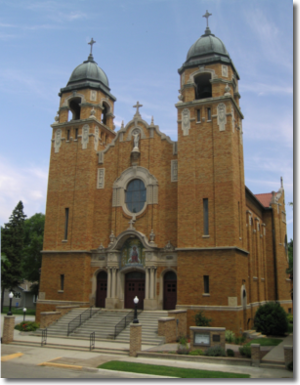
In 1914, Father Mathias Jostock was appointed pastor and parishioners asked for a new church. Construction was to begin in 1916, but was delayed by World War 1. In 1919, this structure was built and was dedicated to the Sacred Heart of Jesus in 1921.
The structure features thirteen large stained class windows, imported from the Franz Binsfeld and Company, Trier, Germany. The windows on the left side depict many of the sacraments and the ones on the right picture some of the commandments. They were donated by members of the parish! Today they are priceless.
In the larger dome above the sanctuary, the center figure is Christ the King, Ruler of the Universe. To the left is Moses holding the tablets of the Ten Commandments. To the right of center is John the Baptist.
Inside the small dome or "baldaquin" is the Lamb of God resting on the Bible. In Jewish sacrifices a lamb was often the sacrificial victim. As a title it was applied directly to Christ by John the Baptist in John:1: 29-34 when he pointed his finger at Christ and declared "Behold the Lamb of God".
The gold tabernacle below the dome holds the consecrated communion hosts between the celebration of the Masses. When the sanctuary lamp is lit, it signifies the presence of Jesus in the Tabernacle.
The marble alter and lectern were added when the church was redecorated in 1975.
The ceiling artwork depicts many instances of biblical history, scripture, and symbols used by the church. In the left front is the Blessed Virgin crushing the head of the Serpent. In the Book of Revelations 12:1, "A great sign appeared in the sky, a woman clothed with the sun, with the moon under her feet, and on her head a crown of twelve stars." To the right side of the archway is St. Michael the Archangel who slew the dragon or serpent symbolizing the forces of evil.
Surrounding the chandelier are the church art animals that are used to describe the four Evangelist who wrote the Gospels. Matthew - depicted as the Human Body, Mark - the Lion's Head, Luke - the Oxen's Head, and John - the Eagle's head. These symbols were taken from the visions of Ezekiel in the Book of revelation. On the arched ceiling, one should be able to identify symbols for Christ, the Trinity, loaves and fishes, the alpha and omega and many other biblical references.
The fourteen bas-relief Stations of the Cross, also imported from Europe, bring life to the passion and death of Christ. They are regarded as outstanding artwork.
Two crystal chandeliers, the larger one in the center of the church =, and one smaller above the choir balcony were imported from Europe. They too were donated by parish members.
Above the choir balcony is an angel with a harp. The figure in the stained glass window above the organ popes is St. Cecilia, who is the patron saint of musicians.
The pipe organ was purchased shortly after the church was built. It had 14,000 distinct tones. In 1984, the organ was reconstructed, adding two and a half ranks of pipes, giving it the ability to produce four million distinct tones. Sacred Heart still has an active choir and sings at all weekend Masses and most funerals.
In the year 2000, Sacred Heart Parish addressed the issue of handicapped accessibility. Restrooms were relocated and the interior of the north bell tower was demolished to provide room for a spacious, hydraulically operated elevator. the elevator provides accessibility to the Sanctuary as well as the church social hall. Most of the work was done by over 100 parish volunteers. Also added was a paved parking area at the elevator entrance.
Above the front entrance of the church is a beautiful mosaic of the Child Jesus. A statue of the Sacred Heart stands high above welcoming all who enter.
The two large bells of Sacred Heart peal a glorious sound across the fields of corn and soybeans, and the twin towers are visible for a great distance.